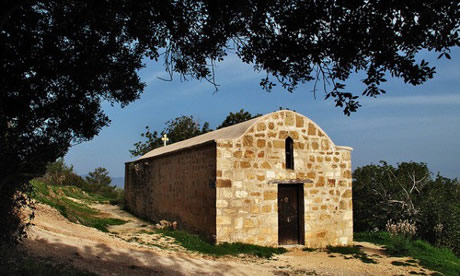Project Description
Church of Agios Minas
The church of Agios Minas is located in the center of the village and began to be built in 1906 and its work was completed in 1912. It is a relatively large church which can accommodate around two hundred believers. It is architecturally built in Gothic style and internally one-room.
Externally it is built with local stone. The bell tower of the church was built later, in 1930 by a donation of a resident of the community. It is high arched, with three electronic bells inside. It is located in the eastern part of the temple and is adjacent to the building. The precinct is large and comfortable where among it, is the monument of the three fallen who fell in November 1956 in the battles against the English, of the struggle 1955 – 1959.
Inside, the church is adorned with frescoes and by the most unique iconostasis of its kind. The iconostasis of the temple is made of walnut and with carving that gives a beautiful note to the temple. Above the iconostasis there is a second and third narrower zone of miniatures. The iconostasis seems to maintain two gates, the beautiful gate and the north gate. The iconostasis is framed by icons built in 1948. As you pass the north gate on your left is the Holy Intention. To the left of the holy intention there is a mural depicting the Nativity of the Lord and the sacrifice of Abraham. Outside the sanctuary in the main church on the north wall continue the frescoes, with the representations of Agios Kyriakos, Agia Aikaterini, Agia Nymfodora, and Profitis Ilias. On the south wall of the church the performances continue with Saint Nektarios, Apostle Paul and Apostle Peter.
There is a special area for women in the church which is also decorated with various frescoes of saints.
The dedicated icon of Agios Minas is located on the right towards the end of the iconostasis and depicts Agios Minas on the horse, a Byzantine type painting and was donated by the nuns of the Monastery of Agios Minas.
Agios Minas, the community of Neos Chorio, Paphos, celebrates on November 11 in the presence of the Metropolitan of Paphos. On the day of the feast of the saint, there are many celebrants and many vows. Agios Minas is considered very miraculous for the community of Neos Chorio Paphos.
Chapel of Agios Georgios
A chapel dedicated to Agios Georgios, built around the end of the 17th and the beginning of the 18th century. It is located within the village, and very close to the church of Agios Minas. It is also located very close to the fountain of Neos Chorio, built since 1926, where water from this village reaches Kefalovrysso.
Architecturally it is of simple type built, single room, and externally built of stone. The bell tower has been recently built, located to the west of the temple with a bell inside. Its precinct is paved and blocked by a decorative wooden railing.
The iconostasis of the church inside is very old and dates from 1800. It is wood carved with four icons which date from 1885. There is a second narrower area above the iconostasis with six smaller images of saints.
The chapel, although small, simple inside, has the comfort to accommodate up to 30 worshipers. About thirty years ago the chapel was maintained by fundraisers and contributions from a member of the village who now lives in Africa.
The chapel is open twice a year, on the day of the feast of St. George on April 23 and on November 3, the day of the collection of the relics of the Saint.
Chapel of Agios Minas
The chapel of Agios Minas after research made by the department of antiquities seems to date back to the 16th century. It is a small and simple church with the comfort to accommodate up to thirty believers. It is located west of the village at a distance of three kilometers. Architecturally, it is a one-room vaulted church. It is located in a wilderness among wild vegetation. Externally it is made of stone and its outer wall is almost one meter wide. Its bell tower is very rough, but it is there to sound for the call of the faithful. Inside the chapel is simple and seems to have been hagiographed. Of course, over the years the hagiographies were altered and destroyed.
The iconostasis of the temple is wooden, simple with few holy icons.
The ‘psaltiri’ also gives its present, wooden, simple construction.
The chapel, although quite outside the village, operates several times a year. There are many who prefer it for various sacraments, mainly baptisms.
The chapel is under the protection of the Department of Antiquities, because it is considered of significant archaeological value.
Chapel of St. Ephraim
The chapel of St. Ephraim is located on a hill at the entrance


